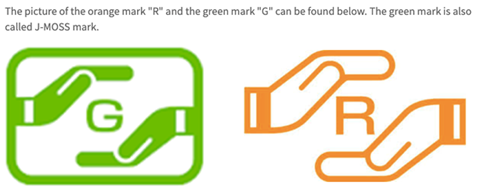Telecom
The MIC (Ministry of Internal Affairs and Communications) grants market approval for Japanese radio / communication products based on the Japan Wireless Communications Act and the Japan Telecom Business Act.
MIC has appointed a Registration Authority (RCB) to certify wireless / communication equipment.
Wireless equipment
The radio law applies to all products that contain radio technology and emit electromagnetic waves.
– Designated Radio Equipment (SRE): Specific radio equipment is a technical regulation of specific radio equipment such as Bluetooth, Wi-Fi, LTE, GSM, ZigBee, wireless microphones, RFID (2.4 GHz, 920 MHz) telemeters, pagers, and UWB radio systems. Means wireless equipment used for small radio stations specified in the certification of compliance.
– Special wireless devices: digital wireless telephone terminals, mobile phone terminals, WiMAX, etc.
* Most SREs must be third-party certified by MIC Designated RC.
– High Frequency Equipment (HFD): IH cooking equipment, microwave ovens, electrodeless discharge lamps, welders, RFID (13.56 MHz), ultrasonic devices, PLCs, other equipment above 10 kHz (including ISMs such as MRI machines, plasma devices, etc.).
– Ultra low power devices are unlicensed and do not require authentication. However, the interference requirements of the radio law must be observed.
The wireless law specifies the following equipment approval systems:
1. Designated wireless devices must obtain type certification or batch certification.
2. Three types of Supplier Declaration of Conformity (SDoC) apply to high frequency equipment (HFD).
– Specification of Type
– Confirmation of Type
– Authorization for Use
Communication equipment
The telecommunications business law applies separately from approval under the wireless law, and terminals can meet the technical requirements of the telecommunications business law and be connected to the network with a Giteki Mark.
The following products are within the scope of telecommunications business laws.
– Terminal equipment that connects to an analog or cellular telephone network
– Terminal equipment that connects to a wireless paging network
– Terminal equipment connected to ISDN
– Terminal equipment that connects to a dedicateed or digital data transmission network
– Terminal equipment that connects to an Internet protocol telephone network
– Terminal equipment to connect to cell phone networks
– Terminal equipment connected to other communications
– Terminal equipment connecting to a dedicated network
– Terminal equipment that connects to an Internet protocol telephone network
The telecommunications business law specifies the following equipment certification system.
– RCB’s technical standard conformity certification
– RCB architectural design certification (type certification)
– Self-control of technical standards satisfaction of manufacturers or importers to ensure that terminal equipment meets the technical conditions set by MIC

Safety
Safety approvals in Japan are based on the Electrical Appliances and Materials Safety Act (DEN-AN), the Consumer Products Safety Act, and the Household Goods Labeling Act.
The Ministry of Economy, Trade and Industry (METI) is the regulatory body for mandatory safety certification and labeling requirements.
1. PSE approval is per DEN-AN law.
METI has appointed a Certification Assessment Authority (CAB) for PSE certification, and the current DEN-AN Act defines approximately 450 electrical appliances and materials, which must comply with the DEN-AN Act or international IEC standard under the CB Scheme.
METI-designated electrical appliances fall into two categories:
1. Designated electrical appliances (116 items are designated as SEPs because they require regulations specifically for safety reasons). These products must pass a conformance test against the registered CAB before the manufacturer or importer attaches the diamond PSE mark to the product.
2. Unspecified electrical appliances (341 items). The manufacturer and importer of this product can test DEN-AN’s technical requirements at the manufacturing stage, keep a copy of the test report and apply the Circle PSE mark to the product to self-declaration of conformity.
The importer is obliged to:
– Submit official notifications to METI
– Verify compliance with technical requirements and perform self-test
– Domestic importers can apply a conformity assessment to a registered CAB and obtain a certificate of conformity for a given electrical appliance and material (SEP).
– The foreign manufacturer may apply the assessment corresponding to the conformity assessment and obtain / retain an official copy of the “corresponding certificate”.
– With PSE Mark
Labeling requirements
The PSE mark is mandatory mark in Japan in accordance with the Electrical Appliances and Materials Safety Act (DEN-AN Act).
Label example:
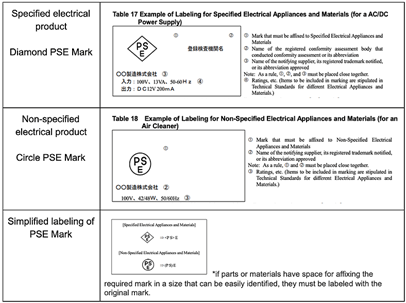
2. Consumer Product Safety Act.
As part of the Japanese market approval, manufacturers must also comply with requirements based on long-term consumer product safety inspection systems.
– Manufacturers or importers of “Special designated products” are required to complete the notification process, evaluate the organization registered by METI (registered CAB), obtain a certificate, and keep the certificate.
– Mark the “standard usage period” (the standard period during which the product can be used safely) as a guide for safe use.
– Product incident reporting (For major accidents involving consumer products such as fire or fatal injuries, the importer or manufacturer of the product concerned must submit an accident report to the Japanese government).
– Put the Consumer Product Safety Mark (PSC Mark) on the product.
There are two types of regulated products.
– “Specific products” requiring self-validation
– “Special designated products” requiring third-party evaluation
Label example:

3. Household goods quality notation.
17 electrical appliances (e.g. washing machines, electric blankets, vacuum cleaners, refrigerators, ventilation fans, air conditioners, etc.) are covered by the Household Appliances Quality Labeling Act and must be marked according to the electrical appliance quality marking standard.
Label example:
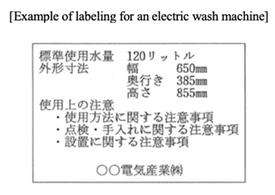
EMC (arbitrary)
As part of the Japanese market approval, manufacturers may also comply with MIC’s requirements for telecommunication compatibility (EMC).
The Information Technology Equipment (ITE) ‘s Japan Voluntary Control Council for Interference (VCCI) is managed by MIC. Under this authority, VCCI creates, publishes and approves Japanese technical EMC standard for limits and methods of measuring electromagnetic interference due to information technology equipment based on CISPR recommendations.
VCCI’s mission is to support voluntary control of radio disturbances emitted by ITE and to promote improved immunity from radio disturbances to ITE to protect the interests of Japanese consumers.
Energy efficiency
Within METI, the Natural Resources and Energy Agency (ANRE) is responsible for ensuring a stable energy supply, promoting the efficient use of energy, and regulating the electricity and other energy industries.
Labeling Requirements:
According to the Energy Conservation Act, energy efficiency labeling of specified products is mandatory. The label should include the product name, model, energy efficiency ratio, and power / fuel consumption.
There are two types of labels.
– Energy Saver Label is a labeling program for manufacturers to demonstrate energy saving performance under the “Top Runner Program”. This label appears on the brochure or in the product itself.
→ The program covers 21 categories of products: air conditioners, fluorescent lighting equipment, TV sets, electric refrigerators, electric freezers, space heaters, gas cookers, gas water heaters, oil water heaters, electric toilet seats, computers
– Uniform Energy Saving Label: Another labeling program for retail stores, the Uniform Energy Saving Label, is a multi-level grading system for energy saving performance based on achievement rates under the Top Runner Program.
The program covers six categories of products: air conditioners, TVs, electric refrigerators, electric freezers, electric toilet seats and fluorescent lighting fixtures.
→ The simplified Uniform Energy Saving Label is displayed for the other 10 products that do not have the Uniform Energy Saving Label applied.
Example of energy saving label:
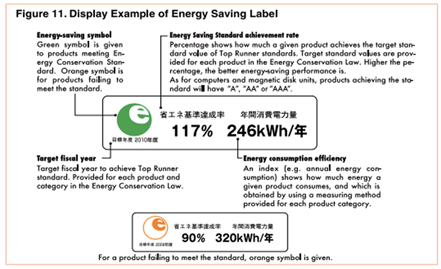
Example of uniform energy saving label:
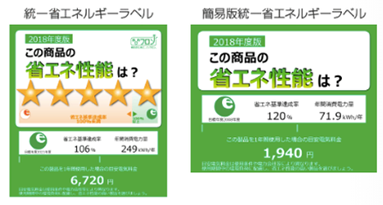
Japan’s International Energy Star Program is a voluntary registration system that has been in operation since January 1995 with agreement between the two governments.
Example of Energy Star label:

RoHS
According to Japan RoHS, manufacturers and importer of seven specific products must comply with Japan’s Resource Utilization Promotion Act (Japan Recycling Law) and Japan’s industry standards. You must also indicate that there are six hazardous substances in certain types of electrical and electronic products.
METI is a RoHS regulator and the following seven types of products fall within the RoHS scope of Japan.
– Personal computer
– Unit type air conditioner
– Television set
– Refrigerator
– Washer
– Clothes dryer
– Microwave
Japan’s RoHS restricts the following six hazardous substances to concentration limits.
– Cadmium (Cd) and its compounds: 0.01%
– Mercury and its compounds: 0.1%
– Lead (Pb) and its compounds: 0.1%
– Hexavalent chromium (Cr6+) and its compounds: 0.1%
– Polybrominated biphenyl (PBB): 0.1%
– Polybrominated diphenyl ether (PBDE): 0.1%
Labeling Requirements
The product should be marked with an orange “R” mark or a green “G” mark, depending on whether the content of the six hazardous substances exceeds the concentration limit. In addition, if the content of one substance in the product exceeds the concentration limit, it must be published in Japanese on the website.
Label example:
